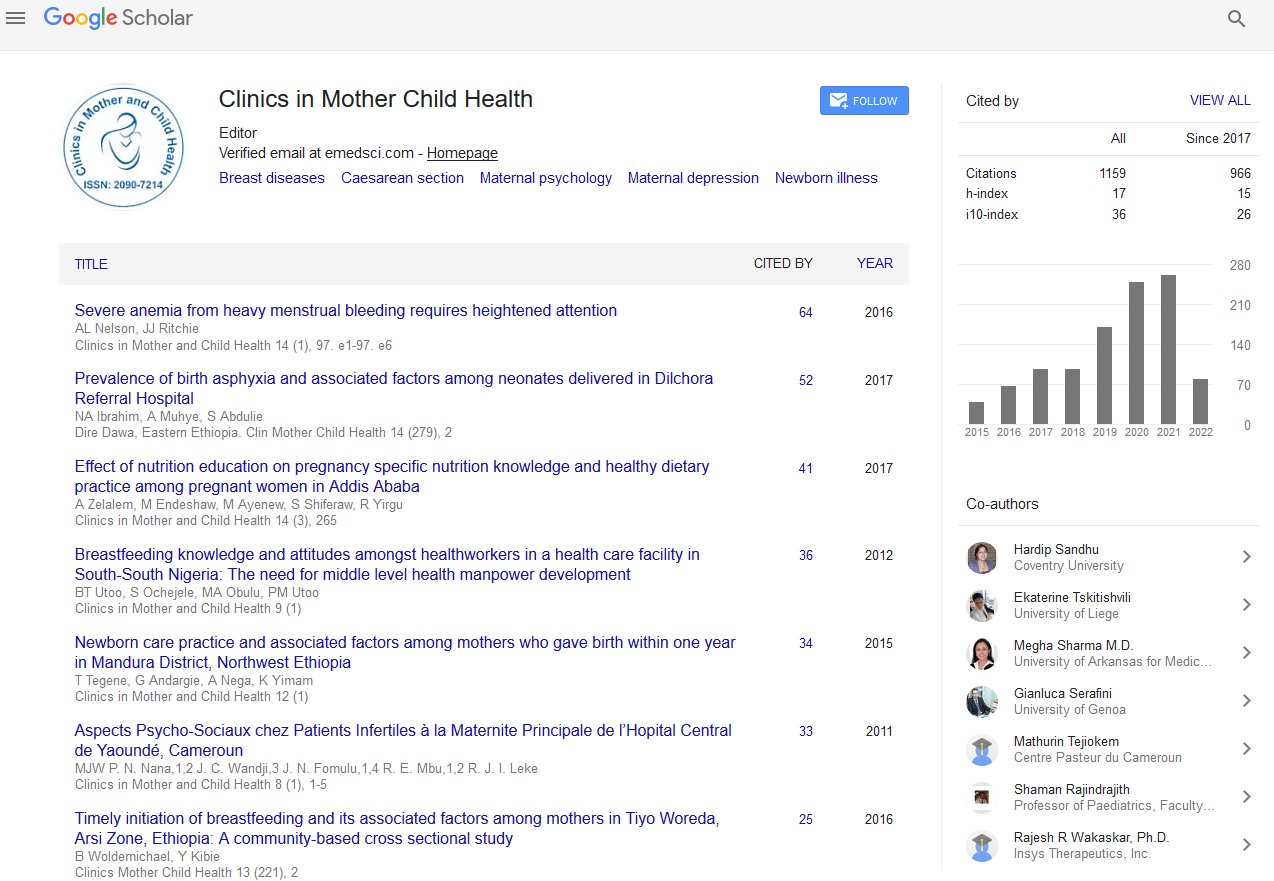Indexed In
- Genamics JournalSeek
- RefSeek
- Hamdard University
- EBSCO A-Z
- Publons
- Geneva Foundation for Medical Education and Research
- Euro Pub
- Google Scholar
Useful Links
Share This Page
Journal Flyer

Open Access Journals
- Agri and Aquaculture
- Biochemistry
- Bioinformatics & Systems Biology
- Business & Management
- Chemistry
- Clinical Sciences
- Engineering
- Food & Nutrition
- General Science
- Genetics & Molecular Biology
- Immunology & Microbiology
- Medical Sciences
- Neuroscience & Psychology
- Nursing & Health Care
- Pharmaceutical Sciences
Editorial - (2021) Volume 18, Issue 6
A Brief note on Endometriosis
Nobuhiko Suganuma*Received: 04-Jun-2021 Published: 25-Jun-2021, DOI: 10.35248/2090-7214.21.18.e356
Editors Words
Endometriosis is a consistently horrendous issue where tissue like the tissue that normally lines inside your uterus-the endometrium-becomes outside your uterus. Endometriosis most as a rule incorporates your ovaries, fallopian tubes and the tissue covering your pelvis. Symptomndometriosis is a consistently unbearable issue where tissue like the tissue that commonly lines inside your uterus-the endometrium-becomes outside your uterus. Endometriosis most as a rule incorporates your ovaries, fallopian tubes and the tissue covering your pelvis.
Dysmenorrhea is the clinical term for torture with period. There are two sorts of dysmenorrhea: "fundamental" and "discretionary". Fundamental dysmenorrhea is customary female issues that are monotonous (returned) and are not a direct result of various diseases. Misery commonly starts1or2daysprior,or when feminine draining beginnings and itself in the lower midriff, back, or thighs. Torture can go from delicate to outrageous, can normally last 12 to72 hours, and can be joined by nausea furthermore, spewing, shortcoming, and surprisingly the runs. Normal female issues by and large become less troublesome as a woman ages and may stop totally if the woman has a newborn child.
Discretionary dysmenorrhea is torture that is achieved by a problem in the woman's conceptive organs, for instance, endometriosis, adenomyosis, uterine fibroids, or defilement. Torture from discretionary dysmenorrhea commonly begins earlier in the month to month cycle and continues to go longer than ordinary ladylike fits. The torture isn't consistently joined by squeamishness, regurgitating, exhaustion, or detachment of the insides. What causes dysmenorrhea (torture of female fits)? Female issues are achieved by compressions (fixing) in the uterus (which is a muscle) by an engineered called prostaglandin. The uterus, where a baby creates, gets all through a woman's period. During month to month cycle, the uterus contracts all the more emphatically. On the off chance that the uterus contracts too earnestly, it can press against nearby veins.
Discretionary dysmenorrhea is torture that is achieved by a problem in the woman's conceptive organs, for instance, endometriosis, adenomyosis, uterine fibroids, or pollution. Torture from discretionary dysmenorrhea ordinarily begins earlier in the month to month cycle and continues to go longer than ordinary ladylike fits. The torture isn't routinely joined by nausea, regurgitating, exhaustion, or detachment of the entrails. What causes dysmenorrhea (torture of female fits)? Female issues are achieved by compressions (fixing) in the uterus (which is a muscle) by an engineered called prostaglandin.
The uterus, where a baby creates, gets all through a woman's period. During month to month cycle, the uterus contracts all the more emphatically. On the off chance that he uterus contracts too determinedly, it can press against nearby veins, eliminating the smoothly of oxygen to the muscle tissue of the uterus. Torture results when a piece of the muscle rapidly loses its smoothly of oxygen. Ladylike desolation from discretionary dysmenorrhea is achieved by an disease in the woman's conceptive organs.
Pelvic anguish can have causes that aren't a direct result of crucial sickness. Models consolidate block, pregnancy, full bladder, sexual torture, ladylike cycle or injury. Three sorts of endometriosis have been depicted: peritoneal shallow endometriosis, ovarian endometriomas, and significant entering endometriosis (DIE). The last normally incorporates the uterosacral ligaments, the rectovaginal space, the upperthird of the back vaginal divider, the gut, and the urinary plot.
Citation: Suganuma N (2021) Editorial Note on Cerebral Palsy in Children. Clinics Mother Child Health. 18:e356.
Copyright: © 2021 Suganuma N. This is an open-access article distributed under the terms of the Creative Commons Attribution License, which permits unrestricted use, distribution, and reproduction in any medium, provided the original author and source are credited.


